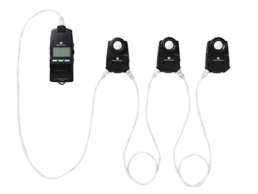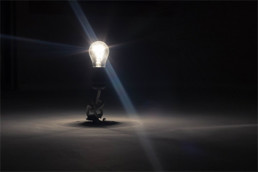Measuring Light Intensity Using a Lux Meter
What are Illuminance Meters?
Illuminance meters are single-element detectors that measure the intensity of light falling upon a surface as perceived by the human eye. It is measured in units known as foot-candles (Fc) or in lux (lx). To perform these measurements, technicians often use lux meters to measure the intensity of light falling on a surface, or “lux.”
What are Luminance Meters?
Luminance meters are single-element detectors filtered to measure photometric brightness as the human eye sees it. Luminance is measured in units known as candelas per meter square (Cd/m2) or Foot Lamberts (Fl). This type of meter measures the brightness of light emitted or reflected from the surface. And they are generally lightweight, compact, and portable. Light meters can use software packages to connect to PCs to control the device and download and evaluate measurement data.
Accurate and quantifiable light measurement is essential in creating desired outcomes in practical day-to-day applications and unique applications. From measuring the amount of light in a workspace surface to ensuring emergency exits have proper illumination, light measurement, and analysis are essential to ensure efficiency and safety.
Examples of practical uses of illuminance / luminance meters:
- Checking for lighting system adequacy in office spaces. More than natural lighting is required to properly illuminate most work and office spaces. Only some have a corner office, which affords them a sea of natural light. Most offices and buildings supplement daylight with synthetic lighting during working hours. Increasing the level of illumination enables people to work safely and efficiently. Light meters ensure that the light levels fall within a certain level where it is bright enough but not too bright to cause glare. In fact, illuminance meters can help enhance productivity because having the correct lighting level means that workers experience less fatigue and, consequently, higher efficiency.
- Enhancing the visibility and utility in outdoor spaces. Streets and parking lots must be well-lit at night. Unfortunately, it can be challenging to ensure that lighting systems perform adequately during nighttime without producing too much light, which can distract motorists and save money on energy bills. Using illuminance meters, though, street lighting and parking lot designers can test the performance of their lighting systems and adjust them to produce the best amount of light and not hamper the night vision of motorists and pedestrians.
- Optimizing light levels in museums and art galleries. Artwork and paintings are often exhibited to many people, and lighting can make or break the exhibit. If the light levels are too low, then viewers can miss details. On the other hand, having too much light will wash out the colors, and the artwork may have a different impact intended by the artist. Museum lighting designers rely on light meters to help them set the correct lighting levels to properly exhibit precious works of art.
Regardless of the application, lighting can be challenging to create effectively. Because many factors influence lighting, such as the type of lighting used and any atmospheric conditions that may be happening, lighting is a complex and challenging aspect of many light-sensitive jobs. Luckily, light meters are small and can be used at multiple points throughout a process or area, so lighting systems can be set up to best utilize natural light and ensure that lighting conditions are optimal for the specific job or application.
Many light meters used around the world have the Konica Minolta name on them. We stay ahead of the competition in the light measurement industry because of an absolute commitment to engineering the highest quality, most accurate measuring instruments on the market. Our instruments help engineers and technicians in a range of industries do their jobs better and faster.
- T-10A Illuminance Meters Series: The T-10A and T10MA are easy-to-use handheld illuminance meters capable of measuring illuminance, integrated illuminance, and illuminance difference. These meters feature an expansive measuring range, automatic range switching, and multipoint measurements.
- CL-200A Chroma Meter: The CL-200A is used for measuring the color and illuminance of light sources, including white LED light sources, and displaying the results in terms of tristimulus values, illuminance, chromaticity, dominant wavelength, excitation purity, correlated color temperature, and difference values from a target.
- CL-500A Illuminance Spectrophotometer: The CL-500A is used for the evaluation of high-class, next-generation lamps such as LEDs and OLEDs. It can measure illuminance, color temperature, color rendering index (CRI), chromaticity, and spectral power distribution.
- LS-150/LS-160 Luminance Meters: The LS-150 Luminance Meters are single element detectors that measure photometric brightness. These luminance meters use a newly designed sensor with a spectral response that more closely matches the V(λ) spectral luminous efficiency function of the human eye to provide measurement results that correlate well with visual evaluation.
- CS-150/CS-160 Chroma Meter: The CS-150 and CS-160 are Luminance and Color Meters that are highly accurate tristimulus colorimeter equipped with newly designed sensors with spectral responses that more closely match the CIE 1931 color-matching functions representing the sensitivity of the human eye to provide measurement results that better correlate with visual evaluation.
- CL-70F CRI Illuminance Meter: The CL-70F CRI Illuminance Meter is an entry-level solution for the measurement and evaluation of the illuminance, color temperature, and color rendering index (CRI) of various illumination sources such as LEDs and fluorescent lamps.
- CS-200 Chroma Meter: The CS-200 measures luminance and chromaticity of light emitting products as diverse as large plasma displays, compact LCDs and LEDs, outdoor screens, high pressure lamps, and instrument panels.
For more information about light measurement meters, and to see how one can be useful for you, complete our contact form.










